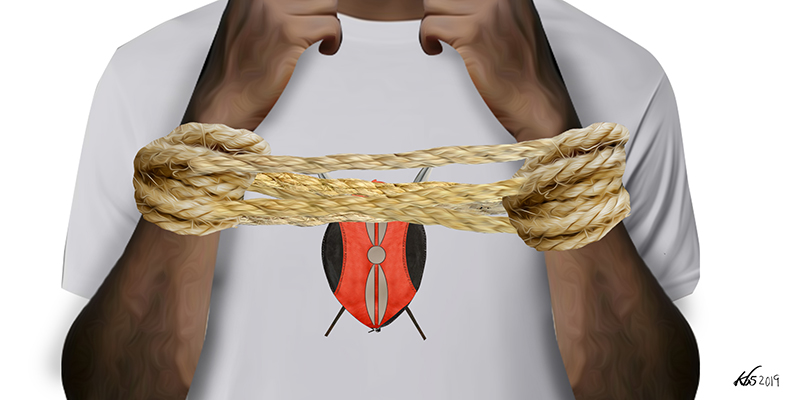Corruption has been a persistent problem in Kenya since before independence but it has flourished and put down robust roots since the country’s return to multiparty politics in 1992. With more democratisation, the government’s infirmity in fighting corruption has also grown proportionately.
The cost of corruption to Kenya is a much-debated figure, but some experts say it is up to 1 per cent of GDP per year. Corruption cases are routinely reported in the press, in the Auditor General’s reports and to the Ethics and Anti-Corruption Commission (EACC) but these are rarely fully investigated let alone resolved satisfactorily.
Commissions of inquiry, such as the Inquiry into the Goldenberg Affair, the Inquiry into Illegal and Irregular Allocation of Public Land, and the Gicheru Commission of Inquiry into Robert Ouko’s death, have achieved little. Even where a commission proposes extensive reforms – as the Inquiry into Illegal and Irregular Allocation of Public Land did – these are implemented in a patchy manner, seemingly “triaged” to exonerate the powerful or to punish their enemies.
Key sectors of the economy – food, land and oil, for example – are vulnerable to periodic heists and systematic mendacity and cover-ups. Reports of investigations done by committees of Parliament, such as the Musikari Kombo list of shame, are either totally rejected or doctored before they are laid before the House, ensuring that no action is ever taken.
Prosecutions fare no better: small fish are nabbed, big fish never. Even where, uncommonly, an indictment is followed by a conviction, the stolen money is rarely recovered. In the handful of cases where monies have been returned, it is usually from lowly officials. In some exceptional cases, the bigwigs will make secret “sweetheart deals” in which they return some token assets but get to keep the greater loot. All this motion without movement is possible because corruption is deeply embedded in politics, which it both funds and subverts.
As the report of the Task Force on Public Collections or Harambees 2003 clearly showed, politicians are the largest donors to so-called charitable causes (churches, schools, higher education and funerals are firm favourites) to which they give fortunes that are many times more than their known legitimate incomes. Such charity is, in truth, a bait-and-switch ploy – once institutions buckle to the lure of corruption money, the corrupt buy absolution and are free to reach deeper into public coffers. The Task Force on Public Collections or Harambees 2003 revealed how intimately corruption is linked to politics. Laws were amended to stop civil servants from getting involved in fund-raising activities. By 2010, however, the law was being honoured more in the breach than in the observance.
Why reforms fail
Reforms come in unsustainable spurts, usually after an election, as in 2003, or in a moment of fiscal crisis, as in 2013 just before Kenya went to the market to issue its first Eurobond. In 2002, in the early phase of the Mwai Kibaki administration, there was frantic action that, for a moment, seemed to herald a fresh beginning in the fight against graft. The national mood was optimistic, exultant and supportive. One thousand procurement officers were suspended after an audit showed widespread irregularities.
Between 2003 and 2007 a raft of new laws were made, buttressing a new set of anti-corruption institutions. Commissions of inquiry and task forces were set up to investigate past scandals and propose additional reforms. These were expectant times: in a 2003 Gallup International survey of more than 67,500 people in 65 countries, Kenyans were ranked the most optimistic people in the world. This result was not a response to any of these reforms, merely the after-glow of the fall of the Daniel arap Moi autocracy. What it says, though, is that the government was riding on a huge wave of a popular “feel-good” moment and legitimacy.
As the report of the Task Force on Public Collections or Harambees 2003 clearly showed, politicians are the largest donors to so-called charitable causes…to which they give fortunes that are many times more than their known legitimate incomes. Such charity is, in truth, a bait-and-switch ploy – once institutions buckle to the lure of corruption money, the corrupt buy absolution and are free to reach deeper into public coffers.
It didn’t last. The laws were no sooner enacted than they were ignored. Task forces and commissions completed their tasks but nothing happened. Notwithstanding the baleful effect of the Goldenberg scandal on the national economy, the commission of inquiry into the scandal, led by Justice Bosire, was irresolute in its recommendations, most of which called for further investigations. The Bosire Commission had been tasked with investigating major financial fraud in the early 1990s involving a company called Goldenberg Ltd. and the Central Bank of Kenya (CBK), in which the CBK and the local banking sector made losses of over $1 billion.
The report of the Kiruki Commission (2006) on the activities of the notorious Artur Brothers never even saw the light of day. The two brothers had been involved in a series of high-profile criminal activities and security breaches in collusion with highly placed Kenyan officials, which included a raid on the premises of the Standard Media Group.
As under the Moi regime, the much-loved commissions of inquiry have proved to be exceptionally weak instruments against graft. Few real changes have come out of the more than 30 commissions of inquiry Kenya has had in a century. And yet taxpayers invest millions in these commissions, expecting a real return by way of official integrity. As one AfriCOG report notes:
The Goldenberg Commission cost Kshs 503 million of which Kshs 200 million was spent on operations and Kshs 303 million on allowances. The Ndung’u Commission cost Kshs 78 million of which Kshs 7.4 million went to operations and Kshs 70.7 million was paid out as allowances. The Kiruki Commission cost Kshs 19.97 million of which Kshs 13.37 was paid out in allowances and Kshs 6.6 million went to operations.
Yet despite all these efforts, President Kibaki failed to actually reduce corruption. Instead, barely a year into the Kibaki presidency, in 2004, the still unresolved Anglo Leasing scandal broke out. By the mid-point of President Kibaki’s first term, most Kenyans had given up hope that corruption could be meaningfully tackled. To date, that has not changed.
The widespread nature of corruption means that Kenya routinely performs very poorly in international and local measures of corruption, integrity and good governance. Since the Transparency International (TI) Corruption Perceptions Index was launched in 1995, Kenya has invariably been in the bottom half of the countries surveyed. Sometimes, the country records some improvement on particular indicators, such as the World Bank’s Government Effectiveness and Doing Business surveys, but generally it soon slips back to its bad ways, or just stagnates. Locally, corruption surveys by TI’s national chapter report widespread bribery. Some institutions, such as the police, land registries and county licencing services, have been reported to have been notoriously predatory.
Thus, a generation of reforms has not dented the corruption edifice or undone its rhizome-like penetration into the body politic in Kenya. Mostly, the government has embraced appearances of reform, rather than the fact of reform and this is so because deep reforms would loosen the ruling elite’s grip on power and severely subvert politics as it is played in Kenya.
State capture
What is at play in Kenya is “state capture” – defined as a political project in which a well-organised elite network constructs a symbiotic relationship between the constitutional state and a parallel shadow state for its own benefit. As defined by Catrina Godinho and Lauren Hermanus, state capture is “. . . a political-economic project whereby public and private actors collude in establishing clandestine networks that cluster around state institutions in order to accumulate unchecked power, subverting the constitutional state and social contract by operating outside of the realm of public accountability.”
If capture is successful, “state institutions, governance, and functions are repurposed and re-engineered over time”, and the constitutional state sheds many of its substantive, but not formal, democratic features and becomes increasingly autocratic, at least in the ways in which power is exercised de facto”.
What is at play in Kenya is “state capture” – defined as a political project in which a well-organised elite network constructs a symbiotic relationship between the constitutional state and a parallel shadow state for its own benefit.
The success of state capture, therefore, rests on the ability of a small group of powerful and rich operatives to take over and pervert the institutions of democracy while keeping the façade of a functioning democracy. Thus, oversight institutions are weakened; law enforcement is partisan and in the pockets of politicians; civic space is asphyxiated; free elections are frustrated and are typically won by the most violent or the most corrupt, or those who are both violent and corrupt; arrests and indictments are often precursors of inaction, not proof of official will to fight corruption.
Essential to state capture is the existence of a crooked, conniving and reciprocal relationship between certain types of businesses and politicians. State capture creates a two-government country: there is an elected government, and there is a shadow government, a state within a state. Capture networks radiate, web-like, from two centres: the Presidency, where the power is concentrated, and the Treasury, where money management is centralised.
Successful state capture networks in Kenya have had two elements. On the bureaucratic side, there is usually a coterie of favoured officials who are allowed to accumulate, concentrate and exercise power in completely unaccountable ways, often behind the shield of presidential privilege, state security or defence procurement. On the business side, there is often a clique of local businessmen allied to political insiders, or alternatively, the favoured groups are shadowy international companies whose shareholders are usually unknown. Capturing and controlling the Presidency, the source of power, and the Treasury, the source of money, is essential to fashioning the “criminal web” necessary to repurpose government for the benefit of rent-seeking elites.
This state capture perspective therefore requires us to see the state elite not as a government at all, but as a vertically integrated criminal organisation that operates in the shadow of the constitutional state. Taking that view, even political rivals are allies who co-exist uneasily, not principally, for the purpose of exercising the functions of the state in the abstract, but primarily and concretely for extracting resources for personal gain. Given its private objectives, the state, seen this way, has no interest in public purposes, such as development, education or health.
This perspective also questions the idea that the Kenyan state is recognisable as such, suggesting instead that institutions are run as noxious, corrupt, criminal fiefdoms. The government, from the presidency to the police, is privatised, with criminal elements operating under unofficial licence from civil authority. The appropriate way to think of the authorities is as organised criminals who have perverted state institutions to maximise predation.
Governance as a “front activity”
Why has state capture been so stable in Kenya, even seemingly able to transition through elections? Well, because the capture elites are not self-annihilating and an unstated rule of capture is that successor regimes will not disturb their predecessors. As John of Salisbury wrote in Policratius:
The raven rejoices in the work of the wolf, and the unjust judge applauds the minister of injustice…in lands whose princes are infidels and companions of thieves; they hasten to embrace those whose misdeeds they observe, thus adding their own share of iniquity in the hope that they may gain for themselves some portion of the spoil.
In this sort of state, governing is really “just a front activity” and to that extent the state is only failing at being a state but is otherwise remarkably effective in achieving its objective, which is to further enrich the state capture elite.
To be able to transition capture across elections, from one regime to another – as Kenya did in 2002 and again in 2013 and 2017 – involves repurposing politics so as to limit the political agency of citizens. To do this successfully, democracy has to be reframed in purely formal and procedural terms. The political class is then able to use the democratic process, especially elections, to frustrate what Michael Johnston calls “deep democratization”. Deep democratization, as opposed to procedural democracy, is:
[The] process whereby citizens become able to defend themselves and their interests by political means. It is “democratization”, not in the sense of establishing formal democratic institutions for their own sake, but rather in the sense of broadening the range of people and groups with some say about the ways power and wealth should—and should not—be pursued, used and exchanged.
In this way, the procedural elements of democracy are used to hollow out its substantive commitments whilst keeping the diplomatic respectability that is conferred by regular elections.
In addition to sequestering democratic concepts for private use in this way, political elites also appropriate moral language and social norms to “conventionalise” corruption, fashioning a vocabulary that removes the moral sting and opprobrium from corruption and its various forms. Corruption is “traditionalised” and reframed as gift-giving or a form of socially recognisable reciprocity.
Why has state capture been so stable in Kenya, even seemingly able to transition through elections? Well, because the capture elites are not self-annihilating and an unstated rule of capture is that successor regimes will not disturb their predecessors.
Corrupt practices are then expressed in the language of moral obligation. No moral wrong is involved when an official or politician from one’s village violates conflict of interest rules or other laws to provide some benefit or to pull strings on behalf of kin and friends of friends. Once a moral bond is accepted as legitimate, a civil servant or politician cannot refuse to profit from “juicy” postings that might benefit him and his people or fail to “spread the benefit around” to his relatives. In this way, the state capture elite syncretically amalgamates traditional practices of gift-giving and reciprocity with their own corrupt and predatory practices that are based on smash and grab and a dollop of tokenism for friends and relatives.
This combination of a democracy drained of substance and communal mores, which are purloined to give social legitimacy to vice, erodes democracy’s emancipatory power and robs the public of the moral resources they need to confront bad governance. As George Steiner points out, political falsehood of this magnitude cuts language from its roots in “moral and emotional life” so that it becomes “ossified with clichés, unexamined definitions, and left-over words”. According to Steiner, this “anaesthetizing” drains “the life-force of the language” and dissolves the society’s moral and political values. Indeed, language is in a parlous condition when the bribe a judge takes to free a dangerous criminal is named chai, like a nice cuppa tea between intimates.
Seeing corruption as a problem of state capture solves many of the persistent puzzles of anti-corruption reform in Kenya. Why do the emblematic corruption cases, such as the Goldenberg, Anglo Leasing or Eurobond scandals, never get resolved even though they never really die? Because they are not meant to be resolved; to resolve them would undo the “implicit transition bargain” of Kenyan politics that successors will not harm the interests of their predecessors. And yet, these emblematic cases cannot really be allowed to die because that would expose the capture racket. Therefore, such cases are kept interminably in the public eye, partly as evidence that “action is live” and partly as a fig leaf to keep the machinery of larceny functioning under cover.
This combination of a democracy drained of substance and communal mores, which are purloined to give social legitimacy to vice, erodes democracy’s emancipatory power and robs the public of the moral resources they need to confront bad governance.
Goldenberg and other post-1992 state capture scandals marked a watershed in corruption politics, that is, “a shift from a politics of state-led control” to “a politics of competitive aggression, the principal victim of which has been the state itself”, says Dominic Burbidge. In this dispensation, politics “has become a pursuit of ever faster forms of enrichment”. These scandals challenge both the theory of democratic consolidation and the supposed “curative” effects of democracy on political corruption.
Kenya under democracy has transformed from a moderately corrupt society to a pervasively corrupt society, and corruption has moved stepwise from “petty or bureaucratic” to “grand or political” and, eventually, to state capture.
This is Part 1 of an abridged version of State Capture: Inside Kenya’s Inability to Fight Corruption, a report published by the Africa Centre for Open Governance (AfriCOG) in May 2019.







